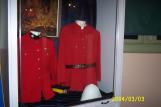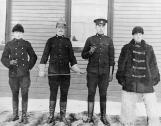27
Excerpts from a journal held by the Fort Saskatchewan Museum and Historical Site.29
Although the Winchester carbine was a popular choice for the force it was not reliable! Commissioner Irvine, reported that it "is altogether too weak in construction to meet the rough handling that at times it is impossible to prevent its receiving". He also reported that it was weak where the shank joined the breech and the rear sight was poorly attached. Complaints were noted in many accounts written by the officers. During the 1880s, in the latter part of August and the beginning of September, Constable John Donkin describes the annual target practice and his discontent with how the Winchester functioned after it had been put through a series of mounted infantry drills and fired the regulated amount of ammunition.30
Part of the regular training routine was target practice, but soon became an annual event due to the expense of the ammunition.31
"The Winchester repeating carbine has been pronounced a failure. The sight of these weapons is lamentably deficient in accuracy, even at 100 yards, and the limit of the range is 500 yards. The trajectory also is very much higher than other military arm."33
Even so, it was ordered on the idea that the vision of a North-West Mounted Police officer armed with a repeater would impress the Indians and Métis as they had acquired repeater rifles, Spencers, the Henry, and the Winchester Model 1866 and 1873.34
Distinctive and Distinguished Dress36
The uniform of the North-West Mounted Police officer was a critical component to establishing a recognizable image of law and order. The gold-trimmed Red Serge was a sharp contrast against the prairie environment and was visible from a long way.When seen, settlers and Indians alike, knew that its presence would instill a peaceful land, secure and orderly. Within the confinements of the force, the uniforms were equipped with distinguishing badges and strips.
In February 1879, the new Police Act had authorized changes to the rank titles to be read with a system of crowns and stars which were to be read with collar and sleeve rank braids and lace. Commissioner was designated with a crown and star; the Assistant Commissioner, a crown; the Superintendent, 2 stars, and Inspector, 1 star.
Reading the badges on the uniforms immediately initiated respect and informed officers on matters of dress protocol.


